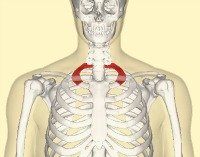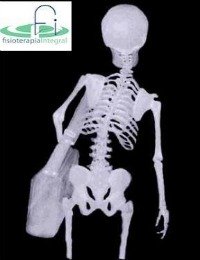The First Rib

One of the primary areas that may be contributing to your Thoracic Outlet symptoms is the first rib. The Brachial Plexus (the nerve bundle that sends sensation to the arm and hand) as well as the arteries and veins that feed the arm pass right over the first rib, under the collarbone.
Problems begin to arise when the first rib becomes locked in a raised position. When this happens, the Brachial Plexus, nerves, veins and arteries can become compressed or even crushed between the first rib and the collarbone.
What Causes The First Rib To Raise?
In most cases, a raised first rib happens because of how you use your body. But in some instances, accidents or injuries to your neck or shoulders can be responsible.
Here's how it happens…
The first rib is suspended in place by the scalene muscles at the side of the neck which tend to pull the rib up, and the intercostal muscles that lie between the ribs and have a tendency to pull the rib down. A dynamic balance is needed between these two muscle groups to keep the first rib in its proper place. When the balance is disturbed for some reason, the position of the first rib can shift.
The scalene muscles are very strong and they have the ability to pull the first rib up if they shorten for any reason. So, what kind of habit or movement pattern can cause the scalene muscles to shorten?
Because the scalenes are prime movers of the neck, most of the problems involving the scalenes have to do with how you move your neck, how you position your head and neck on top of your torso, and the injuries that you have sustained to your neck, upper back and chest that might have altered that natural balance.
The First Rib Is Affected By
How You Use Your Body
The most important thing to consider is how you use your body. We all develop potentially stressful habits of posture, how we sit, how we work, how out of balance our posture might be, etc. When these patterns are repeated enough times, the fascia in and around the scalene muscles will "help" by becoming thicker, denser, and shorter. This shortens the functional length of the scalene muscle group and has the potential to pull the first rib up, pinching or crushing the nerves and blood vessels in the area.

Some common postures that can shorten the scalene muscles are:
1. A forward head posture caused by chronic slouching
2. Leaning on your elbow and sinking into the posture
3. Holding a phone between your shoulder and ear
4. Carrying something with a shoulder strap habitually on the same side
The First Rib And Trauma
The kinds of traumas or injuries that can affect the scalene muscles include any kind of injury to the neck:
1. Whiplash
2. Impacts on one side of the head or neck
3. Birth Trauma (which can last into adulthood)
One last area to consider, especially for people who have bilateral Thoracic Outlet Syndrome where both hands and arms are affected is a past emotional trauma. In a sort of fight-or-flight kind of way, the person could have experienced a fright or other emotional trauma and acted to protect themselves by raising their shoulders or holding their breath. Perhaps you can imagine how this happens. The person feels fear or the need to guard themselves. They suck in a deep, fast breath (which raises their ribs) and then because of the stress or fear, they never fully allow the shoulders and ribs to drop again. Over time this pattern of holding gets cemented in place making it far easier for TOS to develop in the future.
Solutions For First Rib Issues
So what's the solution?
The very first thing to do is to change any habit or posture issue that might be contributing to the shortening of the scalene muscles and the lifting of the first rib.
1. Stop holding the phone between the shoulder and ear.
2. Do not habitually carry bags with a shoulder strap always on the same side. Switch from side to side.
3. Practice carrying a child on either hip, switching frequently.
4. Don't lean on one elbow at any time.
5. Use the Tape Trick to identify other times you might not be aware of when you raise your shoulder.
If you have a posture issue like a forward head (your chin pushes forward in front of your chest), this most commonly gets its start from a habit of slouching. To correct this, it helps to stretch the muscles that can contribute to, and lock you into, those unbalanced postures.
You'll achieve the best relief by stretching the muscles at the sides of your neck (scalenes) and the large cord of muscle at the front of your neck known as the SCM (sternocleidomastoid muscle). In addition, you will see a lot of benefit from stretching the muscles of the chest and abdominals as well as the muscles at the back of the neck.
If you would prefer to go to a therapist who is specially trained to restore your posture to its optimum state, choose a Structural Integration Practitioner. There are many schools of Structural Integration approved by the IASI (International Association of Structural Integrators). You can find links to lists of certified practitioners under the Resources section of this website.
If you suspect that your injury might have a traumatic or emotional origin, it might be helpful to be evaluated by a trained therapist who is familiar with trauma issues.
You can also read about a very effective technique called Emotion Code by visiting www.healerslibrary.com.
What about the medical or surgical approach? (Please keep in mind that I am not a licensed medical doctor so the following is my opinion only. You should discuss your concerns with your personal physician.) Wouldn't it be nice if there was a procedure you could get that would eliminate the problem once and for all?
Unfortunately, any kind of surgical intervention carries with it a very high risk of developing scar tissue over time. This is caused by the fascia being cut during surgery. (You can read more about this on the Fascia page.) This can produce devastating results because once formed, scar tissue is very hard to eliminate or even reduce. And because the area in question (the junction of the neck and shoulder) contains so many structures that can be negatively affected by scar tissue, surgery in the area can create challenges to the thoracic outlet that are hard to overcome.
In my opinion (and take it for what it is…again, I am not a medical doctor), surgical intervention should be your very last option after you have thoroughly exhausted all other options for improving your condition.
Learn more by visiting the following links:
Click the block below that most closely matches your injury for more information and to find the Toolkit we offer to help you in your recovery.







